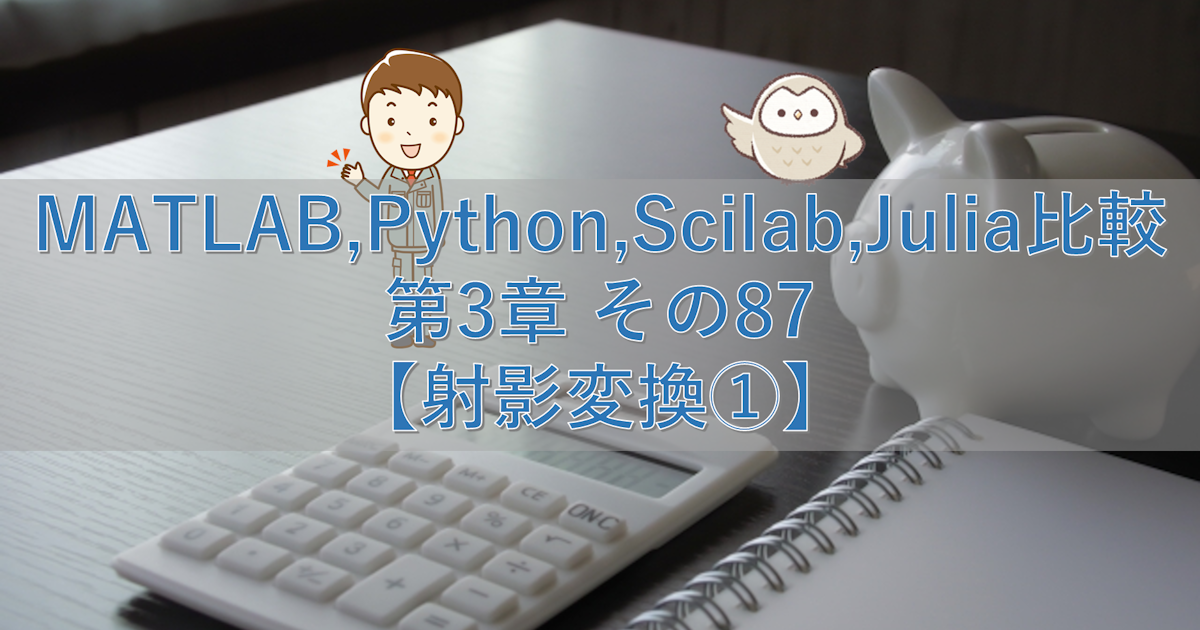バックナンバーはこちら。
https://www.simulationroom999.com/blog/compare-matlabpythonscilabjulia3-backnumber/
はじめに
アフィン変換の拡張と言われている射影変換の話に突入。
拡張と言われているが・・・理屈が一緒とは限らない・・・。
登場人物
博識フクロウのフクさん

イラストACにて公開の「kino_k」さんのイラストを使用しています。
https://www.ac-illust.com/main/profile.php?id=iKciwKA9&area=1
エンジニア歴8年の太郎くん

イラストACにて公開の「しのみ」さんのイラストを使用しています。
https://www.ac-illust.com/main/profile.php?id=uCKphAW2&area=1
次にやること

アフィン変換はできるようになったけど、
次にやることとか決まってるの?

射影変換というのもをやる予定だ。

射影変換?

一般的にはアフィン変換の拡張と言われているものになるな。

ということはアフィン変換を知っていれば、割と楽勝ってことか。

ところが射影変換とアフィン変換は理屈上は全く異なるものだ。

拡張の話はどこいった・・・。

結果的に数式が似るんだよね。
そして、射影変換にアフィン行列を渡すとアフィン変換をしてくれる。
この結果だけをみて、「射影変換はアフィン変換の拡張」と言われているようだな。
射影変換とは?

で、その射影変換ってどんなもの?

まずはWikipediaの記載を引用しよう。
射影幾何学において、n 次元射影空間の射影変換(しゃえいへんかん)とは、射影空間の同型写像である。図学的には中心投影変換に相当する。
Wikipediaより(https://ja.wikipedia.org/wiki/%E5%B0%84%E5%BD%B1%E5%A4%89%E6%8F%9B)

なんか、説明短すぎだな。

じゃー、英語版のWikipediaから引用だ。
In projective geometry, a homography is an isomorphism of projective spaces, induced by an isomorphism of the vector spaces from which the projective spaces derive. It is a bijection that maps lines to lines, and thus a collineation. In general, some collineations are not homographies, but the fundamental theorem of projective geometry asserts that is not so in the case of real projective spaces of dimension at least two. Synonyms include projectivity, projective transformation, and projective collineation.
Wikipediaより(https://en.wikipedia.org/wiki/Homography)
Historically, homographies (and projective spaces) have been introduced to study perspective and projections in Euclidean geometry, and the term homography, which, etymologically, roughly means “similar drawing”, dates from this time. At the end of the 19th century, formal definitions of projective spaces were introduced, which differed from extending Euclidean or affine spaces by adding points at infinity. The term “projective transformation” originated in these abstract constructions. These constructions divide into two classes that have been shown to be equivalent. A projective space may be constructed as the set of the lines of a vector space over a given field (the above definition is based on this version); this construction facilitates the definition of projective coordinates and allows using the tools of linear algebra for the study of homographies. The alternative approach consists in defining the projective space through a set of axioms, which do not involve explicitly any field (incidence geometry, see also synthetic geometry); in this context, collineations are easier to define than homographies, and homographies are defined as specific collineations, thus called “projective collineations”.
↓日本語訳
射影幾何学では、射影は射影空間の同型性であり、射影空間の導出元であるベクトル空間の同型性によって引き起こされます。これは線を線にマッピングする全単射であり、したがって共線化です。一般に、一部の共線はホモグラフィーではありませんが、射影幾何学の基本定理は、少なくとも 2 次元の実射影空間の場合はそうではないと主張しています。同義語には、射影性、射影変換、射影コリネーションなどがあります。
Wikipediaより(https://en.wikipedia.org/wiki/Homography)
歴史的には、ホモグラフィー (および射影空間) は、ユークリッド幾何学における遠近法と射影を研究するために導入されており、語源的には大まかに「類似の描画」を意味するホモグラフィーという用語はこの時代から使われています。19 世紀の終わりに、射影空間の正式な定義が導入されました。これは、無限遠に点を追加してユークリッド空間やアフィン空間を拡張するのとは異なります。「射影変換」という用語は、これらの抽象的な構造に由来しています。これらの構造は、同等であることが示されている 2 つのクラスに分類されます。射影空間は、指定されたフィールド上のベクトル空間(上記の定義はこのバージョンに基づいています)。この構造により、射影座標の定義が容易になり、ホモグラフィーの研究に線形代数のツールを使用できるようになります。別のアプローチは、明示的にいかなる場も関与しない一連の公理を通じて射影空間を定義することにあります (入射幾何学、合成幾何学も参照)。この文脈では、照合はホモグラフィーよりも定義が容易であり、ホモグラフィーは特定の照合として定義されるため、「射影照合」と呼ばれます。

説明は、長けりゃいいってもんじゃねぇの代表みたいだな・・・。

アフィン変換の概念とは異なり、遠近法と射影を利用した手法ってことだな。
まぁ、そこらへんを次回説明していこうと思う。

大半がWikipediaの引用の回だったな・・・。
まとめ

まとめだよ。
- 今回から射影変換に突入。
- 射影変換はアフィン変換の拡張と言われいるが、理屈としては異なるもの。
- 結果的な数式が似ており、アフィン行列で射影変換を行うとアフィン変換が実現できてしまうのが理由と思われる。
- Wikipediaの意味不明な説明を参照。
バックナンバーはこちら。




コメント